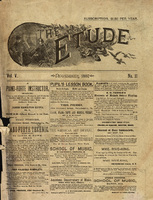BY J. S. VAN CLEVE.
Every one knows that the waltzes of Chopin are not waltzes; that is, not pieces of tuneful clockwork running on three-cogged wheels of rhythm, but impulsive caprices, coquettish fantasies, flowing in the general outline of waltz measure and waltz form. There is, perhaps, no one of them more beautiful or brilliant than that in A flat, Op. 42. Some hints as to its reading and delivery may be of value to piano students.
The first striking peculiarity of this waltz is the triple rhythm of the first strain.
The left hand gives the two parts of a regular waltz accompaniment; that is, a bass tone at the first beat of the measure and two answering chords.
The right hand in the meanwhile is giving two triplets, the upper tone being held throughout the entire triplet.
Thus we have a melody presenting two equal tones in each measure, which against the left hand will appear at the first beat and at the second half of the second beat. This effect is both odd and beautiful. A simultaneous union of melodies totally unlike is found in Mozart’s Don Giovanni, and a smaller example of the same thing is found here. In the next place, we may study the general effect of rubato in these first sixteen measures after the introduction. Rubato may apply either to single measures or to phrases and to periods. The student will easily understand how to produce this stretching of the rhythmical framework if the first measure be taken quite slowly, the second a little faster, the third still faster, the fourth the quickest of all, then the fifth at the same speed as the fourth, the sixth like the third, the seventh like the second, and the eighth as slow as the first.
Treat the second half of the period in the same manner. This pendulous oscillation of the rhythm is also found in the true Viennese manner of playing the Strauss waltzes. The second strain of this A flat waltz, consisting entirely of eighth notes in groups of six, should be held as a foil or contrast to the broad rubato of the first strain; consequently, its rhythm must be strict till the very last two measures, which may retard slightly. A charming diversity may be added here by taking the strain once through with the sordine, or thinning pedal, once without it. Where the melody descends to the lower part of the keyboard and sings in double tones, it should be played with that slight broadening of the short tones and narrowing of the long tones which is so characteristic of Chopin. There are some clashing chords interrupting the steady flow, which must be made brilliant and sonorous like a burst of festal brasses. There is a long, ascending scale in the sharp tonic, which must begin slowly, ascend with accumulating force and speed like a mounting rocket, and close with a brilliant, exploding tone. Such runs are of frequent occurrence in Chopin (witness the double run of the ascending melodic scale of B flat minor in the A flat polonaise, Op. 53), and it requires the skill of a virtuoso to give them with the requisite equality, clearness, strength and speed.



